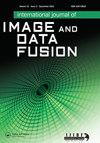一种基于区域的各向异性扩散遥感图像融合方法
IF 1.8
Q3 REMOTE SENSING
International Journal of Image and Data Fusion
Pub Date : 2021-12-26
DOI:10.1080/19479832.2021.2019132
引用次数: 1
摘要
摘要遥感图像融合的目的是将高光谱分辨率多光谱(MS)图像与高空间分辨率全色(PAN)图像融合,得到光谱失真较小的高空间分辨率多光谱图像。传统的像素级融合技术受到光晕效应和梯度反转的影响。为了解决这个问题,研究了一种新的基于区域的各向异性扩散遥感图像融合方法。其基本思想是将MS图像的仅“Y”分量(YCbCr颜色空间的)与PAN图像融合。使用模糊c-均值(FCM)算法对使用AD处理获得的输入图像的基本层和细节层进行分割,并基于它们的空间频率进行组合。融合实验使用了三个数据集。本文的贡献如下:i)它解决了融合时的色度损失问题,ii)首次将基于区域的融合方法的AD滤波器引入遥感应用中,以及iii)保留了输入图像中的边缘信息。将经典方法和最新的最先进方法进行了定性和定量比较。实验结果表明,该方法具有良好的融合效果。本文章由计算机程序翻译,如有差异,请以英文原文为准。
A region based remote sensing image fusion using anisotropic diffusion process
ABSTRACT The aim of remote sensing image fusion is to merge the high spectral resolution multispectral (MS) image with high spatial resolution panchromatic (PAN) image to get a high spatial resolution MS image with less spectral distortion. The conventional pixel level fusion techniques suffer from the halo effect and gradient reversal. To solve this problem, a new region-based method using anisotropic diffusion (AD) for remote sensing image fusion is investigated. The basic idea is to fuse the ‘Y’ component only (of YCbCr colour space) of the MS image with the PAN image. The base layers and detail layers of the input images obtained using the AD process are segmented using the fuzzy c-means (FCM) algorithm and combined based on their spatial frequency. The fusion experiment uses three data sets. The contributions of this paper are as follows: i) it solves the chromaticity loss problem at the time of fusion, ii) the AD filter with the region-based fusion approach is brought into the context of remote sensing application for the first time, and iii) the edge info in the input images is retained. A qualitative and quantitative comparison is made with classic and recent state-of-the-art methods. The experimental results reveal that the proposed method produces promising fusion results.
求助全文
通过发布文献求助,成功后即可免费获取论文全文。
去求助
来源期刊

International Journal of Image and Data Fusion
REMOTE SENSING-
CiteScore
5.00
自引率
0.00%
发文量
10
期刊介绍:
International Journal of Image and Data Fusion provides a single source of information for all aspects of image and data fusion methodologies, developments, techniques and applications. Image and data fusion techniques are important for combining the many sources of satellite, airborne and ground based imaging systems, and integrating these with other related data sets for enhanced information extraction and decision making. Image and data fusion aims at the integration of multi-sensor, multi-temporal, multi-resolution and multi-platform image data, together with geospatial data, GIS, in-situ, and other statistical data sets for improved information extraction, as well as to increase the reliability of the information. This leads to more accurate information that provides for robust operational performance, i.e. increased confidence, reduced ambiguity and improved classification enabling evidence based management. The journal welcomes original research papers, review papers, shorter letters, technical articles, book reviews and conference reports in all areas of image and data fusion including, but not limited to, the following aspects and topics: • Automatic registration/geometric aspects of fusing images with different spatial, spectral, temporal resolutions; phase information; or acquired in different modes • Pixel, feature and decision level fusion algorithms and methodologies • Data Assimilation: fusing data with models • Multi-source classification and information extraction • Integration of satellite, airborne and terrestrial sensor systems • Fusing temporal data sets for change detection studies (e.g. for Land Cover/Land Use Change studies) • Image and data mining from multi-platform, multi-source, multi-scale, multi-temporal data sets (e.g. geometric information, topological information, statistical information, etc.).
 求助内容:
求助内容: 应助结果提醒方式:
应助结果提醒方式:


